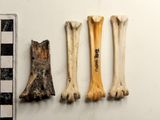Are Kids Still Looking for Careers in Tech?



Future versions of the Laser Interferometer Gravitational Wave Observatory (LIGO) will be able to run at much higher laser powers thanks to a sophisticated new system that compensates for temperature changes in optical components. Known as FROSTI (for FROnt Surface Type Irradiator) and developed by physicists at the University of California Riverside, US, the system will enable next-generation machines to detect gravitational waves emitted when the universe was just 0.1% of its current age, before the first stars had even formed.
Gravitational waves are distortions in spacetime that occur when massive astronomical objects accelerate and collide. When these distortions pass through the four-kilometre-long arms of the two LIGO detectors, they create a tiny difference in the (otherwise identical) distance that light travels between the centre of the observatory and the mirrors located at the end of each arm. The problem is that detecting and studying gravitational waves requires these differences in distance to be measured with an accuracy of 10-19 m, which is 1/10 000th the size of a proton.
LIGO overcame this barrier 10 years ago when it detected the gravitational waves produced when two black holes located roughly 1.3 billion light–years from Earth merged. Since then, it and two smaller facilities, KAGRA and VIRGO, have observed many other gravitational waves at frequencies ranging from 30–2000 Hz.
Observing waves at lower and higher frequencies in the gravitational wave spectrum remains challenging, however. At lower frequencies (around 10–30 Hz), the problem stems from vibrational noise in the mirrors. Although these mirrors are hefty objects – each one measures 34 cm across, is 20 cm thick and has a mass of around 40 kg – the incredible precision required to detect gravitational waves at these frequencies means that even the minute amount of energy they absorb from the laser beam is enough to knock them out of whack.
At higher frequencies (150 – 2000 Hz), measurements are instead limited by quantum shot noise. This is caused by the random arrival time of photons at LIGO’s output photodetectors and is a fundamental consequence of the fact that the laser field is quantized.
Jonathan Richardson, the physicist who led this latest study, explains that FROSTI is designed to reduce quantum shot noise by allowing the mirrors to cope with much higher levels of laser power. At its heart is a novel adaptive optics device that is designed to precisely reshape the surfaces of LIGO’s main mirrors under laser powers exceeding 1 megawatt (MW), which is nearly five times the power used at LIGO today.
Though its name implies cooling, FROSTI actually uses heat to restore the mirror’s surface to its original shape. It does this by projecting infrared radiation onto test masses in the interferometer to create a custom heat pattern that “smooths out” distortions and so allows for fine-tuned, higher-order corrections.
The single most challenging aspect of FROSTI’s design, and one that Richardson says shaped its entire concept, is the requirement that it cannot introduce even more noise into the LIGO interferometer. “To meet this stringent requirement, we had to use the most intensity-stable radiation source available – that is, an internal blackbody emitter with a long thermal time constant,” he tells Physics World. “Our task, from there, was to develop new non-imaging optics capable of reshaping the blackbody thermal radiation into a complex spatial profile, similar to one that could be created with a laser beam.”
Richardson anticipates that FROSTI will be a critical component for future LIGO upgrades – upgrades that will themselves serve as blueprints for even more sensitive next-generation observatories like the proposed Cosmic Explorer in the US and the Einstein Telescope in Europe. “The current prototype has been tested on a 40-kg LIGO mirror, but the technology is scalable and will eventually be adapted to the 440-kg mirrors envisioned for Cosmic Explorer,” he says.
Jan Harms, a physicist at Italy’s Gran Sasso Science Institute who was not involved in this work, describes FROSTI as “an ingenious concept to apply higher-order corrections to the mirror profile.” Though it still needs to pass the final test of being integrated into the actual LIGO detectors, Harms notes that “the results from the prototype are very promising”.
Richardson and colleagues are continuing to develop extensions to their technology, building on the successful demonstration of their first prototype. “In the future, beyond the next upgrade of LIGO (A+), the FROSTI radiation will need to be shaped into an even more complex spatial profile to enable the highest levels of laser power (1.5 MW) ultimately targeted,” explains Richardson. “We believe this can be achieved by nesting two or more FROSTI actuators together in a single composite, with each targeting a different radial zone of the test mass surfaces. This will allow us to generate extremely finely-matched optical wavefront corrections.”
The present study is detailed in Optica.
The post New adaptive optics technology boosts the power of gravitational wave detectors appeared first on Physics World.

Australian company HEO has imaged and modeled a mystery Chinese satellite prior to its reentry into Earth’s atmosphere, revealing previously unknown details about the spacecraft.
The post HEO’s satellite-to-satellite imaging uncovers secrets of Chinese tech-test spacecraft appeared first on SpaceNews.

The defense and intelligence community is entering a new era of autonomy, one defined by AI-driven workflows that are reshaping how we handle geospatial intelligence (GEOINT). Agents are beginning to […]
The post From Analyst to AI Orchestrator: Evolving Roles in the Age of Autonomy appeared first on SpaceNews.

Astrobotic Technology says it now plans to launch its large lunar lander carrying a commercial rover no earlier than mid-2026.
The post Astrobotic delays Griffin-1 lander mission to mid-2026 appeared first on SpaceNews.

In a pilot program, the 4th Infantry Division will use Kymeta’s Osprey u8 terminals designed to communicate with both low Earth orbit and geostationary satellites
The post Kymeta to supply flat-panel satellite antennas to U.S. Army appeared first on SpaceNews.

Japan launched the first of a new generation of cargo spacecraft to the International Space Station, with potential applications beyond low Earth orbit.
The post H3 launches first HTV-X cargo spacecraft appeared first on SpaceNews.






NGSO systems drive explosive growth as satellite connectivity becomes mission-critical for modern defense operations Paris, France [October, 2025] – Novaspace has released the first edition of its Satellite Communications for […]
The post Global Defense Satcom Commercial Service Revenues Positioned to Skyrocket Past $8.6 Billion by 2034 appeared first on SpaceNews.


The United States’ goal of completing a crewed moon mission before China has been coined as the new space race, reminiscent of the days of Apollo. Similar to Apollo and the space race with the Soviet Union, the principle of non-sovereignty is at issue as is the rule-based international order. The issue of non-sovereignty in […]
The post A soft power strategy to preserve non-sovereignty from Chinese land claims on the moon appeared first on SpaceNews.
Radiation treatment for patients with lung cancer represents a balancing act, particularly if malignant lesions are centrally located near to critical structures. The radiation may destroy the tumour, but vital organs may be seriously damaged as well.
The standard treatment for non-small cell lung cancer (NSCLC) is stereotactic ablative body radiotherapy (SABR), which delivers intense radiation doses in just a few treatment sessions and achieves excellent local control. For ultracentral lung legions, however – defined as having a planning target volume (PTV) that abuts or overlaps the proximal bronchial tree, oesophagus or pulmonary vessels – the high risk of severe radiation toxicity makes SABR highly challenging.
A research team at GenesisCare UK, an independent cancer care provider operating nine treatment centres in the UK, has now demonstrated that stereotactic MR-guided adaptive radiotherapy (SMART)-based SABR may be a safer and more effective option for treating ultracentral metastatic lesions in patients with histologically confirmed NSCLC. They report their findings in Advances in Radiation Oncology.
SMART uses diagnostic-quality MR scans to provide real-time imaging, 3D multiplanar soft-tissue tracking and automated beam control of an advanced linear accelerator. The idea is to use daily online volume adaptation and plan re-optimization to account for any changes in tumour size and position relative to organs-at-risk (OAR). Real-time imaging enables treatment in breath-hold with gated beam delivery (automatically pausing delivery if the target moves outside a defined boundary), eliminating the need for an internal target volume and enabling smaller PTV margins.
The approach offers potential to enhance treatment precision and target coverage while improving sparing of adjacent organs compared with conventional SABR, first author Elena Moreno-Olmedo and colleagues contend.
The team conducted a study to assess the incidence of SABR-related toxicities in patients with histologically confirmed NSCLC undergoing SMART-based SABR. The study included 11 patients with 18 ultracentral lesions, the majority of whom had oligometastatic or olioprogressive disease.
Patients received five to eight treatment fractions, to a median dose of 40 Gy (ranging from 30 to 60 Gy). The researchers generated fixed-field SABR plans with dosimetric aims including a PTV V100% (the volume receiving at least 100% of the prescription dose) of 95% or above, a PTV V95% of 98% or above and a maximum dose of between110% and 140%. PTV coverage was compromised where necessary to meet OAR constraints, with a minimum PTV V100% of at least 70%.
SABR was performed using a 6 MV 0.35 T MRIdian linac with gated delivery during repeated breath-holds, under continuous MR guidance. Based on daily MRI scans, online plan adaptation was performed for all of the 78 delivered fractions.
The researchers report that both the PTV volume and PTV overlap with ultracentral OARs were reduced in SMART treatments compared with conventional SABR. The median SMART PTV was 10.1 cc, compared with 30.4 cc for the simulated SABR PTV, while the median PTV overlap with OARs was 0.85 cc for SMART (8.4% of the PTV) and 4.7 cc for conventional SABR.
In terms of treatment-related side effects for SMART, the rates of acute and late grade 1–2 toxicities were 54% and 18%, respectively, with no grade 3–5 toxicities observed. This demonstrates the technique’s increased safety compared with non-adaptive SABR treatments, which have exhibited severe rates of toxicity, including treatment-related deaths, in ultracentral tumours.
Two-thirds of patients were alive at the median follow-up point of 28 months, and 93% were free from local progression at 12 months. The median progression-free survival was 5.8 months and median overall survival was 20 months.
Acknowledging the short follow-up time frame, the researchers note that additional late toxicities may occur. However, they are hopeful that SMART will be considered as a favourable treatment option for patients with ultracentral NSCLC lesions.
“Our analysis demonstrates that hypofractionated SMART with daily online adaptation for ultracentral NSCLC achieved comparable local control to conventional non-adaptive SABR, with a safer toxicity profile,” they write. “These findings support the consideration of SMART as a safer and effective treatment option for this challenging subgroup of thoracic tumours.”
SMART-based SABR radiotherapy remains an emerging cancer treatment that’s not available yet in many cancer treatment centres. Despite the high risk for patients with ultracentral tumours, SABR is the standard treatment for inoperable NSCLC.
The phase 1 clinical trial, Stereotactic radiation therapy for ultracentral NSCLC: a safety and efficacy trial (SUNSET), assessed the use of SBRT for ultracentral tumours in 30 patients with early-stage NSCLC treated at five Canadian cancer centres. In all cases, the PTVs touched or overlapped the proximal bronchial tree, the pulmonary artery, the pulmonary vein or the oesophagus. Led by Meredith Giuliani of the Princess Margaret Cancer Centre, the trial aimed to determine the maximum tolerated radiation dose associated with a less than 30% rate of grade 3–5 toxicity within two years of treatment.
All patients received 60 Gy in eight fractions. Dose was prescribed to deliver a PTV V100% of 95%, a PTV V90% of 99% and a maximum dose of no more than 120% of the prescription dose, with OAR constraints prioritized over PTV coverage. All patients had daily cone-beam CT imaging to verify tumour position before treatment.
At a median follow-up of 37 months, two patients (6.7%) experienced dose-limiting grade 3–5 toxicities – an adverse event rate within the prespecified acceptability criteria. The three-year overall survival was 72.5% and the three-year progression-free survival was 66.1%.
In a subsequent dosimetric analysis, the researchers report that they did not identify any relationship between OAR dose and toxicity, within the dose constraints used in the SUNSET trial. They note that 73% of patients could be treated without compromise of the PTV, and where compromise was needed, the mean PTV D95 (the minimum dose delivered to 95% of the PTV) remained high at 52.3 Gy.
As expected, plans that overlapped with central OARs were associated with worse local control, but PTV undercoverage was not. “[These findings suggest] that the approach of reducing PTV coverage to meet OAR constraints does not appear to compromise local control, and that acceptable toxicity rates are achievable using 60 Gy in eight fractions,” the team writes. “In the future, use of MRI or online adaptive SBRT may allow for safer treatment delivery by limiting dose variation with anatomic changes.”
The post A SMART approach to treating lung cancers in challenging locations appeared first on Physics World.

